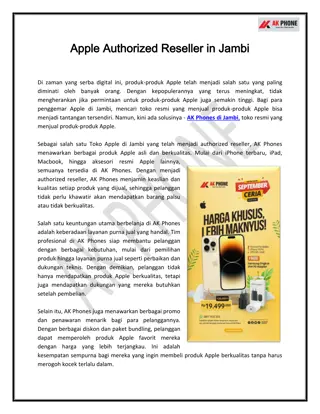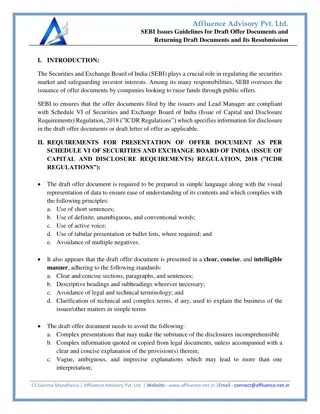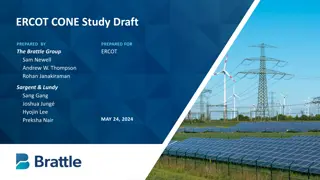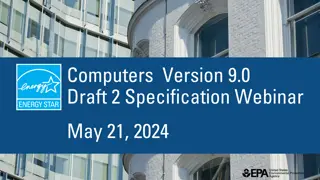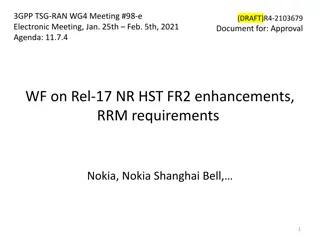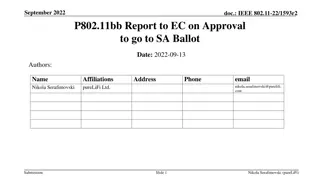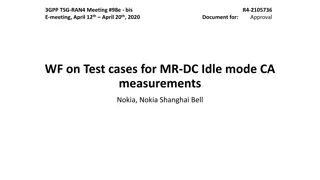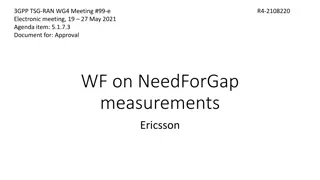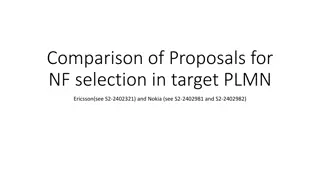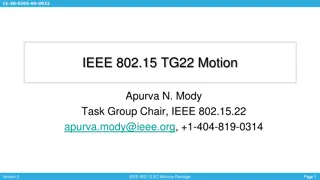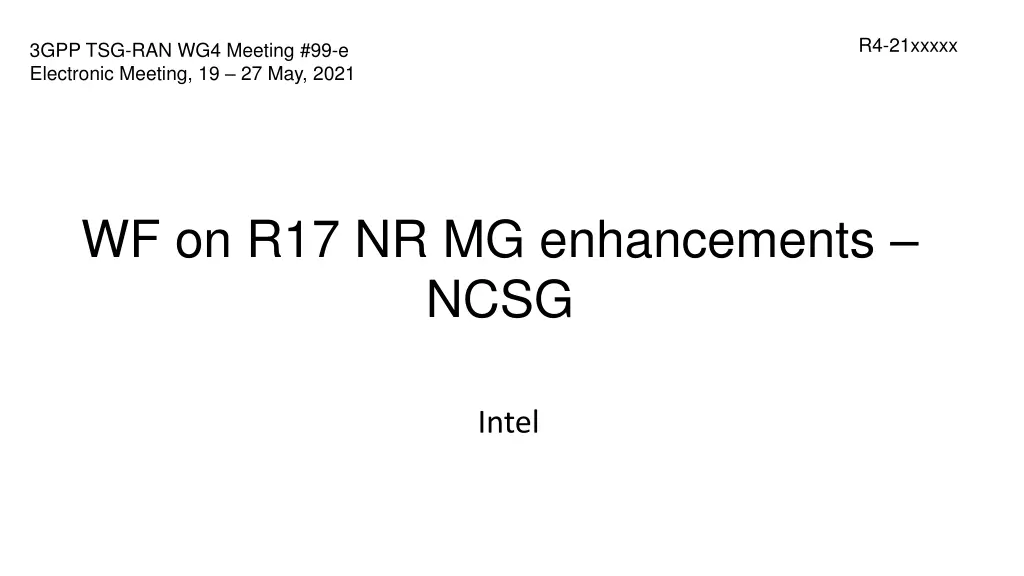
Enhanced NR Measurement Gap Patterns Discussion at 3GPP TSG-RAN WG4 Meeting
Explore the discussions and agreements at the 3GPP TSG-RAN WG4 Meeting #99-e regarding R17 NR Measurement Gap enhancements. Topics include NCSG patterns, scenarios for NCSG usage, and defining NCSG patterns for legacy MG operations with insights from various industry stakeholders.
Download Presentation

Please find below an Image/Link to download the presentation.
The content on the website is provided AS IS for your information and personal use only. It may not be sold, licensed, or shared on other websites without obtaining consent from the author. If you encounter any issues during the download, it is possible that the publisher has removed the file from their server.
You are allowed to download the files provided on this website for personal or commercial use, subject to the condition that they are used lawfully. All files are the property of their respective owners.
The content on the website is provided AS IS for your information and personal use only. It may not be sold, licensed, or shared on other websites without obtaining consent from the author.
E N D
Presentation Transcript
R4-21xxxxx 3GPP TSG-RAN WG4 Meeting #99-e Electronic Meeting, 19 27 May, 2021 WF on R17 NR MG enhancements NCSG Intel
Agreements in the 1st round/GTW Agreements in the 2nd round open for 2nd round discussion Still open after 2nd round discussion
Scenarios and use cases In principle, NCSG can be used for intra-frequency measurements with MG, inter-frequency measurements with MG, inter-RAT measurements. FFS on whether NW should configure the legacy MG rather than NCSG even UE can support both of them. Measuring deactivated SCC shall be studied as one scenario forof NCSG usage as we agreed unless the critical issues werewas identifiedacknowledged.
NCSG pattern (1) Define NCSG patterns for subset of the legacy MG patterns in [TS38.133 v16.5.0]. FFS on which subset of legacy MG patterns FFS on RAN4 needs to be define separate NCSG patterns for sync and async scenarios Option 1 (Ericsson, Nokia, Intel, Qualcomm): Yes Different NCSG patterns for synchronous and asynchronous operations in FR1 Same NCSG patterns for synchronous and asynchronous operations in FR2. Option 2 (ZTE, OPPO, Huawei,MTK,vivo, CATT): No need to separate NCSG patterns needed for synchronous and asynchronous operations. Option 3 (CMCC, MTK, vivo, Apple): same NCSG patterns for synchronous and asynchronous operations, provided that the NCSG pattern only comprise the RF retuning time and ML. Interruption is not captured in VIL(RRT) and specified separately.
NCSG pattern (2) FFS on gap pattern index for NCSG VIL: Option 1a (Qualcomm, Intel, Ericsson, vivo, ZTE, OPPO): VIL should be explicitly defined based on the number of interrupted durations in absolute time Option 1b (Apple, CATT, Qualcomm, ZTE): VIL should be explicitly defined based on the number of interrupted duration in slot Option 2( MTK, Huawei, CMCC, Nokia): based on absolute RF retuning time (tentatively denoted as RRT ).
NCSG pattern (23) FFS on ML of NCSG (or the total length of NCSG). Option 1: the total length of NCSG ( ML + VIL1+VIL2 ) is same as MGL of the legacy gap Option 2: the total length of NCSG ( ML + VIL1+VIL2 ) is larger than MGL of the legacy gap and the effective measurement window of NCSG (which is equal to ML) is same as legacy MGL 2 *RRTT) .
NCSG configuration FFS on explicit configuration for NCSG Option 1 (OPPO, Intel) NCSG configuration shall be based on legacy MG configuration Option 1a (MTK, HW, OPPO ) : Introduce a single bit for existing MeasGapConfig to transform the legacy gap into NCSG (detail to be left to RAN2). Option 2(CATT): Up to RAN2 FFS other options
Impacts on RRM requirements due to NCSG(1) FFS on Interruption requirements Option 1: The interruption requirements in TS38.133 and TS36.133 shall be revisited Option 2: Existing interruption requirements for SCell activation/deactivation can serve as starting point for the study of VIL requirements Option 3: the interruption is proposed as following SCS Synchronous Asynchronous interruption length b e f measurement 1 slot 2 slots 3 slots 6 slots interruption length a f t measurement 1 slot 2 slots 3 slots 6 slots interruption length before measurement interruption length after measurement o r e e r 15KHz SCS 30KHz SCS 60KHz SCS 120KHz SCS 2 slots 3 slots 4 slots 7 slots 2 slots 3 slots 4 slots 7 slots Option 3a :Translate 1ms(FR1) and 0.75ms(FR2) into the number of interrupted slots for defining the interruption requirements for the synchronous case and one more slot is added for asynchronous case. Option 4 VIL on active victim serving cells is the number of interrupted slots calculated based on Aggressor reference cell RRT, Victim cell SCS, and Sync or async. operation Option 5: RAN4 to further discuss the condition, capability and impacts to measurement requirements for UE to use NCSG to control interruptions due to measurement on deactivated SCC or Scell in dormancy The existing measurement mode requirements (effective MGRP, data scheduling depends on gap configuration) can be the baseline
Impacts on RRM requirements due to NCSG(2) FFS on Per-UE or Per-FR capability support Option 1:per UE and per FR NCSG for RRM measurement needs the specific UE capability. Option 2: No additional NCSG capability for per-UE and per-FR differentiation is needed Others CCSF Only one layer can be measured for each NCSG occasion, which is the assumption for deriving CSSF
Measurement applicability Defer to the discussion on simultaneous configuration of NCSG and legacy MG based on concurrent MG framework to the in a 2ndstage of this WI. FFS on Rx beam limitation Option 1. (MTK, Ericsson, Huawei): NCSG pattern is also supported for FR2 Option 1a. (MTK)NW needs to be informed that the inter-frequency measurements with NCSG is CBM or IBM with serving cells in FR2. Option 2(CATT) NCSG in FR2 should be deprioritized in current stage. FFS on scheduling and measurement restriction Option 1 (Ericsson, CATT): When NCSG is configured then during the ML the existing scheduling restriction requirements defined in TS 38.133 shall also apply, Option 1a(Qualcomm): RAN4 to discuss if existing scheduling restrictions of 9.2.5.3.3 for measurement on FR2 intra-frequency cell shall be extended for the use case of measurement on intra- or inter-frequency cell via NCSG instead of legacy MG. Option 2(Huawei, OPPO, Intel): Scheduling restriction for NCSG is FFS, and check with RAN2 on the feasibility of informing NW the CBM or IBM between inter-frequency measurements and serving cells in FR2.
Signaling FFS on necessary signaling for NCSG Option 1 (Huawei, Qualcomm): Signalling supports for NCSG include at least NCSG configuration UE capability related to NCSG patterns and per-UE/per-FR NCSG UE capability related to need for NCSG for a target carrier Option 2 (Nokia, Ericsson): Defer these discussions after NCSG pattern design as well as NCSG applicability and UE capability support are finalized Other options was not excluded FFS on How to consider the relation between NCSG and NeedForGap ? Option 1 (Intel, Apple): The NeedForGap signaling structure can be reused for NR NCSG as a start point Option 1a (MTK, ZTE, Apple): Rel-17 NCSG capability is reported on top of existing RAN2 NeedForGap signaling structure with a new component NCSG . Option 2 (Ericsson, CMCC, OPPO, Qualcomm): Don t reuse Rel-16 NeedForGap signaling for NCSG Option 3(Ericsson, CATT, Qualcomm, OPPO): Let RAN2 decide NCSG signaling details and any relation between NCSG and NeedForGap based on RAN4 technical input on NCSG pattern design Note: regardless of the selected option, decision will involve RAN2 feedback




